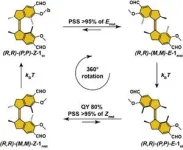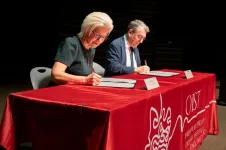(Press-News.org) Light-driven molecular motors were first developed nearly 25 years ago at the University of Groningen, the Netherlands. This resulted in a shared Nobel Prize for Chemistry for Professor Ben Feringa in 2016. However, making these motors do actual work proved to be a challenge. A new paper from the Feringa lab, published in Nature Chemistry on 26 April, describes a combination of improvements that brings real-life applications closer.
First author Jinyu Sheng, now a postdoctoral researcher at the Institute of Science and Technology Austria (ISTA), adapted a ‘first generation’ light-driven molecular motor during his PhD studies in the Feringa laboratory. His main focus was to increase the efficiency of the motor molecule. ‘It is very fast, but only 2% of the photons that the molecule absorbs drive the rotary movement.’
Increased efficiency
This poor efficiency can get in the way of real-life applications. ‘Besides, increased efficiency would give us better control of the motion,’ adds Sheng. The rotary motion of Feringa’s molecular motor takes place in four steps: two of them are photochemical, while two are temperature-driven. The latter are unidirectional, but the photochemical steps cause an isomerization of the molecule that is usually reversible.
Sheng set out to improve the percentage of absorbed photons that drive rotary motion. ‘It is very difficult to predict how this can be done and, in the end, we accidently discovered a method that worked.’ Sheng added an aldehyde functional group to the motor molecule, as a first step in further transformation. ‘However, I decided to test the motor function of this intermediate version and found it to be very efficient in a way that we had never seen before.’
For this, he cooperated with the Molecular Photonics group at the University of Amsterdam’s Van ‘t Hoff Institute for Molecular Sciences. Using advanced laser spectroscopy and quantum chemical calculations the electronic decay pathways were mapped, providing detailed insight in the working of the molecular motor.
Rotation cycle
Furthermore, it became clear that the adaption indeed gave Sheng better control of the molecule’s rotary movement. As mentioned before, the molecular motor rotates in four discrete steps. Sheng: ‘Previously, if we irradiated a batch of motors with light, we would get a mixture of motors at different stages of the rotation cycle. After the modification, it was possible to synchronize all motors and control them at each stage.’
This opens up all kinds of possibilities. For example, the motors could be used as a chiral dopant in liquid crystals, where the different positions would create different reflection colours. In the Nature Chemistry paper, Sheng and his colleagues present an example of this. Other applications could, for example, be the control of molecular self-assembly.
Applications
The addition of an aldehyde group to the motor molecule also has another interesting effect: it shifts the absorption of light to a longer wavelength. Since longer wavelengths penetrate further into living tissue or bulk material, this means that the motors could work much more efficiently in medical applications and materials science because more light will reach the motor molecule, while this will also use the photons more efficiently.
‘A number of our colleagues are now working with us on this new molecular motor for different applications,’ says Sheng. He expects more papers on this topic in the near future. Meanwhile, there is another challenge for the Feringa lab: ‘The molecular motor is now more efficient but we don’t exactly know why the modification causes this effect. We are currently working on it!’
Reference: Jinyu Sheng et al., Formylation boosts the performance of light-driven overcrowded alkene-derived rotary molecular motors, Nature Chemistry 26 April 2024.
END
More efficient molecular motor widens potential applications
2024-04-26
ELSE PRESS RELEASES FROM THIS DATE:
Robotic nerve ‘cuffs’ could help treat a range of neurological conditions
2024-04-26
Researchers have developed tiny, flexible devices that can wrap around individual nerve fibres without damaging them.
The researchers, from the University of Cambridge, combined flexible electronics and soft robotics techniques to develop the devices, which could be used for the diagnosis and treatment of a range of disorders, including epilepsy and chronic pain, or the control of prosthetic limbs.
Current tools for interfacing with the peripheral nerves – the 43 pairs of motor and sensory nerves that connect the brain and the spinal cord – are outdated, bulky and carry a high risk of nerve injury. However, the robotic nerve ‘cuffs’ ...
Researchers identify targets in the brain to modulate heart rate and treat depressive disorders
2024-04-26
Study led by Brigham investigators suggests heart rate may be a useful tool to determine where to stimulate the brains of individuals with depressive disorders when brain scans aren’t available
A new study by researchers at Brigham and Women’s Hospital, a founding member of the Mass General Brigham healthcare system, suggests a common brain network exists between heart rate deceleration and depression. By evaluating data from 14 people with no depression symptoms, the team found stimulating some parts of the brain linked to depression with transcranial magnetic stimulation ...
Findings of large-scale study on 572 Asian families supports gene-directed management of BRCA1 and BRCA2 gene carriers in Singapore
2024-04-26
Singapore, 26 April 2024 – A team of clinician-scientists and scientists from the University of Nottingham (Malaysia campus), National Cancer Centre Singapore (NCCS), Cancer Research Malaysia, Nanyang Technological University, Singapore (NTU Singapore), University of Malaya, University of Cambridge, A*STAR’s Genome Institute of Singapore (GIS) and other institutions, have conducted the largest study done to date of BRCA1 and BRCA2 (BReast CAncer Gene 1 and 2) carriers in an Asian population and refined breast and ovarian cancer risk estimates for this population. The findings, ...
Many children with symptoms of brain injuries and concussions are missing out on vital checks, national US study finds
2024-04-26
Almost a quarter of US children with symptoms of a brain injury or concussion are not checked for the condition, with younger children particularly likely to be overlooked, a new national study finds.
The peer-reviewed US research, which is published in the journal Brain Injury, also shows that children with symptoms or a diagnosis of a brain injury or concussion were more likely to have symptoms of depression than other youngsters. They also found it harder to make friends.
Routine checks would help ensure such children receive the care that they need, says ...
Genetic hope in fight against devastating wheat disease
2024-04-26
Fungal disease Fusarium head blight (FHB) is on the rise due to increasingly humid conditions induced by climate change during the wheat growing season, but a fundamental discovery by University of Adelaide researchers could help reduce its economic harm.
While some types of wheat are resistant to FHB thanks to the action of the TaHRC gene at the Fhb1 locus, how this gene functions in wheat cells was unknown until now.
Collaborating with Nanjing Agriculture University, the University of Adelaide research team has shown TaHRC works in the nucleus of wheat cells, ...
Mutualism, from biology to organic chemistry?
2024-04-26
Heteroatom tin compounds (SSn, OSn, NSn, PSn) composed of heteroatoms S, O, N, P and tin atoms have attracted intense attention due to their wide applications in organic synthesis and pharmaceutical fields. The current methods for synthesis of such compounds, such as metathesis reactions, addition reactions, and free radical reactions, exhibit drawbacks including narrow substrate scope and harsh conditions. Therefore, it is important to develop efficient synthetic systems to construct heteroatom-tin bond.
Tetrahydroquinoline, as an important ...
POSTECH Professor Yong-Young Noh resolves two decades of oxide semiconductor challenges, which Is published in prestigious journal Nature
2024-04-26
Professor Yong-Young Noh from the Department of Chemical Engineering at Pohang University of Science and Technology (POSTECH), along with Dr. Ao Liu and Dr. Huihui Zhu, postdoctoral researchers from the Department of Chemical Engineering at POSTECH and now professors at the University of Electronic Science and Technology of China, Dr. Yong-Sung Kim from Korea Research Institute of Standards and Science, and Dr. Min Gyu Kim from the Pohang Accelerator Laboratory, collaborated on the development of a tellurium-selenium composite oxide semiconductor material. Their efforts led to the successful creation of a high-performance and highly ...
Could fishponds help with Hawaiʻi’s food sustainability?
2024-04-26
Indigenous aquaculture systems in Hawaiʻi, known as loko iʻa or fishponds, can increase the amount of fish and fisheries harvested both inside and outside of the pond. This is the focus of a study published by a team of researchers at the University of Hawaiʻi at Mānoa Hawaiʻi Institute of Marine Biology (HIMB). Today, aquaculture supplies less than 1% of Hawaiʻi’s 70 million pounds of locally available seafood, but revitalization of loko i‘a has the potential to significantly increase locally available seafood.
According to historical accounts, loko ...
International network in Asia and Europe to uncover the mysteries of marine life
2024-04-26
The Okinawa Institute of Science and Technology (OIST) and France’s National Centre for Scientific Research (CNRS) have signed a letter of intent to work towards establishing an international research lab and agreeing on comprehensive academic collaboration.
The signing ceremony took place during the opening session of the OIST-CNRS Joint Symposium on West Pacific Marine Biology on April 23. Dr. Karin Markides, President and CEO, and Professor Vincent Laudet were among the speakers from OIST, and they were joined by representatives from CNRS, namely Dr. André ...
Anthropologist documents how women and shepherds historically reduced wildfire risk in Central Italy
2024-04-26
In the last several decades, large forest fires have increasingly threatened communities across the Mediterranean. Climate change is expected to make these fires larger, hotter, and more dangerous in the future. But fire management lessons from the past could help to improve the resilience of local landscapes.
The latest research paper from environmental anthropologist and University of California, Santa Cruz Professor Andrew Mathews explores these issues in the Monte Pisano region of Central Italy. In particular, Mathews found that peasant women, who historically collected ...








